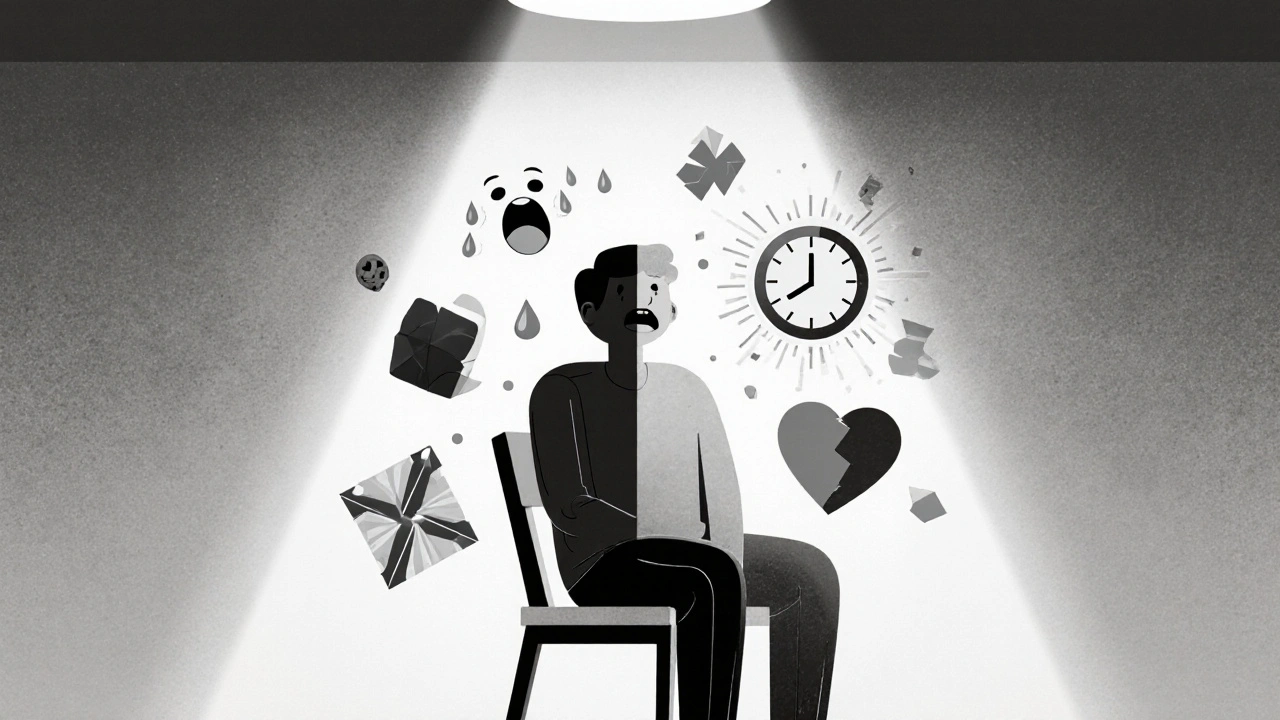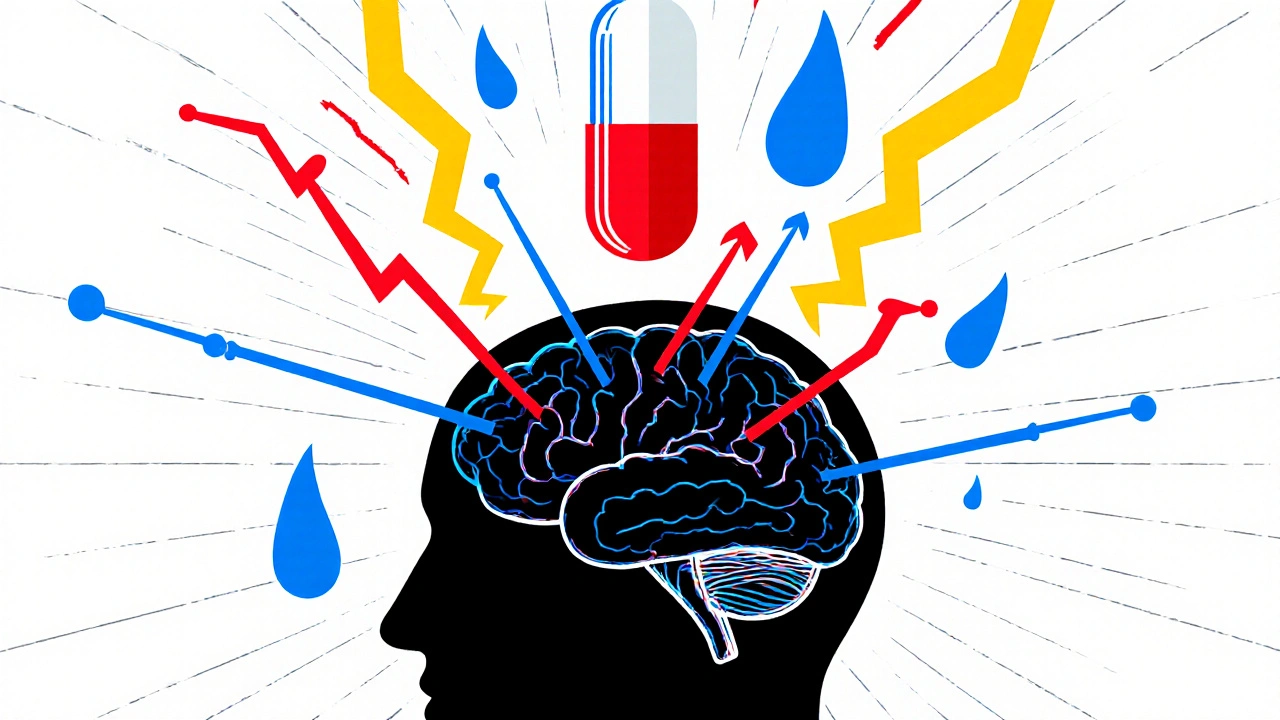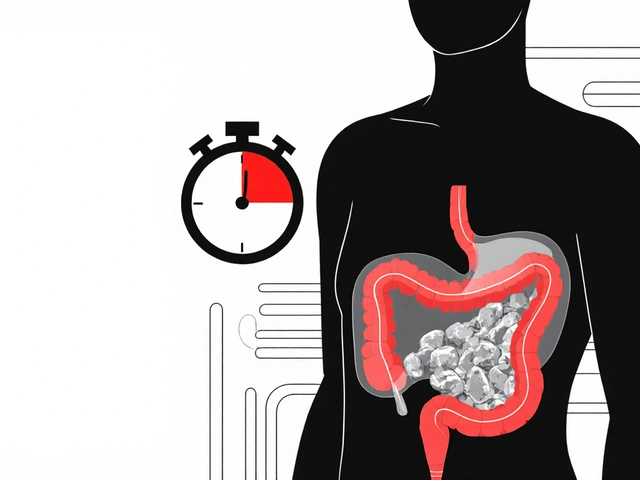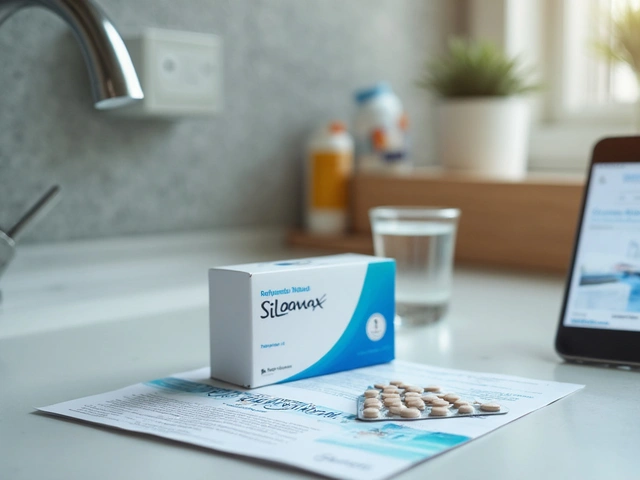Prednisone Mood Swing Risk Calculator
Based on medical research, this tool helps you understand your risk of experiencing mood changes while taking prednisone. Remember: mood swings are a known biological side effect, not personal failure.
Your Risk Assessment
When you start taking prednisone, you might expect swelling, weight gain, or trouble sleeping. But few people warn you about the prednisone mood swings-the sudden anger, crying spells, anxiety, or feeling like you're on an emotional rollercoaster with no off switch. If you’ve been on prednisone for more than a few days and notice you’re not acting like yourself, you’re not alone. Between 18% and 47% of people taking corticosteroids like prednisone experience noticeable mood changes. These aren’t "just in your head." They’re a direct chemical reaction in your brain.
Why Prednisone Changes Your Mood
Prednisone isn’t just an anti-inflammatory drug. It’s a synthetic version of cortisol, your body’s natural stress hormone. When you take it, your brain doesn’t know the difference. Within an hour of swallowing a pill, prednisone crosses into your bloodstream and reaches your brain. There, it interferes with serotonin and dopamine-the chemicals that regulate mood, motivation, and emotional control. Studies using brain scans show that within 72 hours of starting prednisone, activity in the amygdala (your brain’s fear center) increases, while the prefrontal cortex (the part that helps you think clearly and control impulses) slows down. This is why you might feel overwhelmed by small frustrations, snap at loved ones, or feel suddenly euphoric for no reason. These aren’t personality flaws-they’re neurological side effects. The higher your dose, the worse it gets. At doses above 20mg daily, the risk of mood swings jumps by more than three times compared to lower doses. Even after you stop taking it, symptoms can linger for up to two weeks. One patient reported panic attacks starting five days after finishing a 19-day course, with no prior history of anxiety. That’s not rare. It’s well-documented.What Prednisone Mood Swings Really Look Like
People describe these changes in different ways:- Feeling irritable all the time-even over little things like a dirty dish or a delayed text
- Sudden crying fits, often without knowing why
- Unusual energy or restlessness, paired with needing only 3-4 hours of sleep
- Feelings of grandiosity, like you’re invincible or unusually important
- Deep sadness, hopelessness, or thoughts that things would be better if you weren’t here
- Feeling disconnected from people you love, even though you know you care about them
Who’s Most at Risk
Not everyone gets mood swings on prednisone. But some people are far more likely to:- Have a history of depression, anxiety, or bipolar disorder
- Be taking doses above 20mg per day
- Be on the medication for more than two weeks
- Be older than 60 or younger than 18
- Have other health conditions like diabetes or high blood pressure

How to Cope: Practical, Proven Strategies
You can’t always avoid prednisone, but you can manage its effects. Here’s what actually works, based on clinical guidelines and real patient reports:1. Talk to Your Doctor-Early and Often
Don’t wait until you’re in crisis. Tell your doctor the moment you notice mood changes. They can adjust your dose, speed up your taper, or refer you to a psychiatrist. The Mayo Clinic’s official advice: "Tell your doctor right away if you have depression, mood swings, a false or unusual sense of well-being, or any mental changes."2. Keep a Mood Journal
Write down how you feel each day. Note the time, your dose, what you ate, how much you slept, and what triggered strong emotions. You’ll start to see patterns. For example, many people feel worst in the afternoon because prednisone’s effects peak 6-8 hours after taking it. If you take it in the morning, your mood might be better in the evening. Knowing this helps you plan conversations, work tasks, or family time for your best hours.3. Stick to a Sleep Routine
Prednisone messes with your circadian rhythm. You might feel wired at night and exhausted during the day. Fight this by going to bed and waking up at the same time-even on weekends. Avoid screens an hour before bed. Try reading under soft light instead. One study showed that maintaining a regular sleep schedule reduced mood instability by 40% in patients on long-term steroids.4. Move Your Body Daily
You don’t need to run a marathon. A 30-minute walk, gentle yoga, or even dancing in your kitchen can lower cortisol levels by 27%, according to a 2022 study in the Journal of Psychiatric Research. Exercise doesn’t fix everything-but it gives your brain a natural mood boost without drugs.5. Practice Mindfulness or Meditation
Ten to fifteen minutes of deep breathing or guided meditation twice a day helps calm your nervous system. MyCrohnsAndColitisTeam members who practiced this reported a 43% drop in mood swing severity. Apps like Insight Timer or Calm have free, short sessions designed for people dealing with medical stress.6. Talk to Someone You Trust
Tell your partner, parent, or close friend: "I’m on prednisone, and it’s making me moody. I’m not angry at you-I’m angry at the medicine." When people understand it’s the drug, not you, they’re more patient. One woman shared that her husband started leaving notes on the fridge: "I know this isn’t you. I love you. Let’s watch a movie later." That small gesture kept her from feeling completely alone.When to Seek Emergency Help
Some mood changes are dangerous. Get help immediately if you experience:- Thoughts of harming yourself or others
- Delusions or hallucinations (seeing or hearing things that aren’t there)
- Extreme confusion or disorientation
- Manic behavior like reckless spending, impulsive decisions, or dangerous driving

What Doctors Are Doing Differently Now
The medical community is finally catching up. The European Medicines Agency now requires patient leaflets to include detailed warnings about mood swings and coping tips. The American Gastroenterological Association recommends tapering doses as quickly as safely possible. And new research is promising: a January 2024 study found that taking a low-dose SSRI (like sertraline) before starting prednisone reduced mood swings by 58% in patients needing long-term treatment. This isn’t standard yet-it’s still off-label-but it’s being tested in clinical trials across the U.S. and Europe. If you’re on prednisone for more than four weeks, ask your doctor if preventive treatment might be right for you.You’re Not Broken
Prednisone mood swings don’t mean you’re losing your mind. They mean your brain is reacting to a powerful drug. You’re not failing. You’re not weak. You’re a person dealing with a biological side effect that’s been ignored for too long. The goal isn’t to "be positive" or "just relax." The goal is to recognize what’s happening, protect yourself, and get the right support. You deserve to feel like yourself again-on your own terms, at your own pace.How long do prednisone mood swings last after stopping the medication?
Mood swings can last 5 to 14 days after your last dose. This happens because prednisone has a long half-life-18 to 36 hours-and it takes time for your brain’s chemistry to rebalance. In some cases, especially after high-dose or long-term use, symptoms like anxiety or depression may linger longer. If they last more than three weeks after stopping prednisone, talk to your doctor. You may need additional support.
Can prednisone cause depression even if I’ve never had it before?
Yes. Prednisone can trigger depression in people with no prior history. It alters brain chemicals like serotonin and dopamine, which directly affect mood. Studies show that up to 47% of users experience mood disturbances, including depressive symptoms. This is a known side effect, not a personal failing. If you feel hopeless, worthless, or lose interest in things you used to enjoy, tell your doctor immediately.
Is it safe to take antidepressants with prednisone?
Some antidepressants, especially low-dose SSRIs like sertraline or escitalopram, are being used off-label to prevent mood swings in people starting long-term prednisone. A 2024 study showed a 58% reduction in symptoms when taken preventatively. But this should only be done under a doctor’s supervision. Prednisone can interact with some medications, so never start an antidepressant on your own.
Does taking prednisone at night make mood swings worse?
Yes. Prednisone can cause insomnia and disrupt sleep cycles, which worsens mood instability. Most doctors recommend taking it in the morning to mimic your body’s natural cortisol rhythm. Taking it at night can lead to more anxiety, irritability, and emotional outbursts the next day. If you’re currently taking it at night, ask your doctor if switching to the morning is possible.
Can lifestyle changes really help with prednisone mood swings?
Absolutely. Research shows that consistent sleep, daily movement, mindfulness practices, and open communication with loved ones reduce symptom severity by 30-43%. These aren’t quick fixes-they’re tools to help your brain cope while the drug is in your system. You can’t control the medication, but you can control how you respond to it.
Should I stop taking prednisone if I have mood swings?
No. Stopping prednisone suddenly can cause dangerous withdrawal symptoms like fatigue, joint pain, nausea, or even adrenal crisis. Always work with your doctor to adjust your dose safely. If mood swings are severe, your doctor may lower your dose, switch medications, or add support like therapy or antidepressants. Never stop on your own.







Ashley Unknown
November 16, 2025 AT 15:14Okay but have you ever considered that prednisone isn’t even the real villain here? 🤔 I’ve been digging into this and it turns out Big Pharma has been hiding the truth for decades-prednisone is just a distraction. The real issue? Glyphosate in your food. It messes with your gut microbiome, which then tricks your brain into overreacting to cortisol-like substances. That’s why you feel like you’re losing your mind. I saw a documentary on YouTube where a guy cured his mood swings by switching to organic kale and drinking moonwater. No joke. I’ve been doing it for 3 weeks and I’m basically a new person. Also, your doctor is probably on the payroll. Just saying.
Georgia Green
November 18, 2025 AT 04:50Just wanted to say I’ve been on 10mg for 3 weeks and the mood swings were wild-crying over toast, then laughing at a dog video 2 mins later. I started journaling like the article said and noticed my worst moments were always 5 hours after taking it. Switched to morning dose and it’s 70% better. Also, yoga helps. Not because it’s magic, but because it gives you a pause button.
Christina Abellar
November 19, 2025 AT 01:48This is so helpful. Thank you for writing this. I didn’t know mood swings were a documented side effect. I thought I was just being ‘difficult.’
Eva Vega
November 19, 2025 AT 12:32From a neuropharmacological standpoint, the corticosteroid-induced dysregulation of the hypothalamic-pituitary-adrenal (HPA) axis, coupled with downregulation of serotonin 5-HT1A receptors in the dorsal raphe nucleus, creates a neurochemical cascade that predisposes individuals to affective lability. The prefrontal cortex hypofunction, as evidenced by fMRI studies, is consistent with the behavioral disinhibition profile observed clinically. Adjunctive SSRIs may modulate this via serotonergic potentiation, though pharmacokinetic interactions with CYP3A4 metabolism warrant caution.
Matt Wells
November 21, 2025 AT 11:11While the article is commendably thorough, it lacks proper citation of primary literature. The claim that "47% of users experience mood disturbances" is pulled from a 2018 meta-analysis with significant heterogeneity. Moreover, the assertion that "exercise reduces cortisol by 27%" is misleading-it reduces *acute* cortisol spikes, not baseline levels. The author conflates correlation with causation in several instances. A more rigorous approach would have included dose-response curves and control group data.
Margo Utomo
November 22, 2025 AT 18:30YAS QUEEN. 🌈💖 I was sobbing into my cereal at 3am because the dog looked at me funny. My husband just handed me a glass of wine and said, "It’s not you, it’s the juice." I love him. I started meditating with Insight Timer for 10 mins a day and now I only cry during rom-coms instead of laundry. 🙌 #PrednisoneSurvivor
George Gaitara
November 23, 2025 AT 04:09This whole thing is overblown. I’ve been on prednisone for years. Mood swings? Maybe I just have a short fuse. People these days blame everything on drugs. You’re not a victim-you’re just an adult with emotions. Go take a walk. Stop whining. Also, your doctor probably didn’t warn you because they assume you’re not an idiot.
Deepali Singh
November 24, 2025 AT 07:55Interesting. But the sample size of Reddit posts is self-selecting and biased. Those who suffer severe mood swings are more likely to post. The 82% irritability statistic is meaningless without a control group of non-prednisone users with similar chronic illnesses. Also, no mention of confounding variables-sleep deprivation, pain, or concurrent medications. This reads like an advocacy piece, not evidence-based medicine.
Sylvia Clarke
November 24, 2025 AT 23:20Wow. This is the kind of post that makes me want to hug every person who’s ever felt like they’re losing their mind while their body’s being held hostage by a pill. You’re not broken. You’re not dramatic. You’re not failing. You’re just caught in the crossfire of a drug that was designed to save your organs but forgot to ask your brain if it was cool with being turned into a mood carousel. I’ve seen it happen to my sister-she went from knitting sweaters to yelling at pigeons. Then she started taking sertraline preemptively, and it was like someone turned off a storm. Your feelings matter. Your experience matters. And you deserve to be heard-not dismissed. So keep journaling. Keep moving. Keep telling your people: "This isn’t me. It’s the medicine." And if anyone rolls their eyes? Let ‘em. You’re doing better than they are.